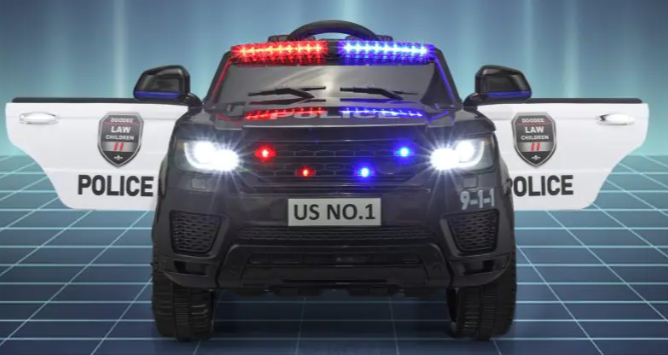Ride on police car in https://us.tobbi.com/ has emerged as an exciting topic of discussion when it comes to law enforcement vehicles. These vehicles leverage modern battery technology to provide a more environmentally friendly and cost-effective means of policing. However, the battery life and charging considerations are crucial aspects to ensure the reliability and longevity of electric police car toy. In this article, we will delve into the battery life and the charging precautions that need to be adhered to while using these vehicles.
Challenges and Opportunities in Ride on Police Car Battery Life
Advancements in Battery Technology
Over time, battery technology has continued to advance. More efficient and durable batteries are becoming the standard for ride on police car, extending their operational life. Innovative battery technologies offer longer driving ranges and faster charging times, which are essential for responding to emergencies efficiently.
Fast-charging technology is a game-changer for police car ride on. Newer batteries can accept higher charging currents, leading to significantly reduced charging times. This is crucial for law enforcement, as it minimizes downtime between shifts or emergency responses.
Development of Charging Infrastructure
The expansion of charging infrastructure provides police ride on car with more charging options. Law enforcement agencies can choose to use fast-charging stations, reducing downtime when the vehicles are not in use. Furthermore, smart technology at charging stations helps optimize battery charging and maintenance.
The deployment of fast-charging stations is particularly significant for police car ride on toy. These stations can deliver high-power charging, allowing vehicles to be quickly recharged during breaks or while on duty. Fast charging minimizes downtime, ensuring that electric police cars are readily available for emergencies.
Importance of Battery Management Systems
Battery management systems play a critical role in extending the battery life of battery operated police car toy. These systems monitor the battery’s status to ensure it operates under optimal conditions. Law enforcement agencies can maintain battery performance through regular maintenance and inspections while taking appropriate measures to prevent overcharging or deep discharging.
BMS plays a crucial role in managing the battery’s temperature. It monitors and regulates the battery’s temperature to prevent overheating, which can pose safety risks and reduce the battery’s lifespan. Effective thermal management ensures consistent performance even in extreme conditions. Ride on police cars batteries consist of multiple cells, and BMS helps balance the voltages of these cells. Balancing ensures that no individual cell is overcharged or undercharged, optimizing the overall performance and safety of the battery pack.

Charging Considerations for Ride on Police Car
Selecting Appropriate Charging Equipment
Law enforcement agencies should ensure they use charging equipment that is compatible with their battery powered police car ride on. Different models of police cars may require different types of charging plugs, making it crucial to select the right equipment.
Consider the charging speed and power levels offered by the charging equipment. Fast-charging stations with higher power outputs can significantly reduce charging time, ensuring that police car ride on is ready for duty as quickly as possible. Choose charging equipment that is part of a well-established charging network. This ensures that law enforcement officers have access to a reliable and extensive charging infrastructure, reducing the risk of encountering charging station compatibility issues or downtime.
Follow Manufacturer Recommendations
Manufacturers typically provide specific advice and guidelines regarding charging police ride on car. This guidance includes information on charging rates, frequency, and temperature ranges. Law enforcement agencies should closely adhere to the manufacturer’s recommendations to ensure the long-term health of the batteries.
Consider the standardization of charging connectors within your fleet. Standardizing on a specific connector type can simplify the charging process and reduce the need for multiple adapters, streamlining operations and minimizing potential compatibility issues. Charging equipment with load management features allows law enforcement agencies to distribute available power effectively among multiple charging stations. This ensures that all ride on toy police car can charge efficiently without overloading the electrical grid.
Regular Maintenance and Monitoring
Electric police car ride on batteries require regular maintenance and monitoring. This includes checking the battery’s state of charge, temperature, and alerts from the battery management system. Timely detection and resolution of issues can extend the battery’s life.
Conduct periodic assessments of the battery’s health using diagnostic tools and software. These assessments can provide insights into the battery’s state of charge, state of health, and overall condition. Addressing battery issues promptly can prevent unexpected failures. Maintain appropriate temperature conditions for the battery operated police car battery powered ride on fleet. Extreme temperatures, both hot and cold, can affect battery performance and lifespan. Adequate garage facilities with temperature control can help preserve battery health.
Avoid Extreme Conditions
Avoid exposing police car ride on toy to extreme temperatures, humidity, or other harsh conditions. These conditions can negatively impact battery performance. When possible, provide suitable storage and charging environments. Implement temperature management strategies to shield real toy police cars from excessively hot or cold environments. This may include providing covered parking areas or climate-controlled storage facilities. Extreme temperatures can accelerate battery degradation, so maintaining a controlled environment is paramount.
Avoid parking ride on police car with remote control in direct sunlight for extended periods, especially during hot weather. Excessive heat can cause the battery to overheat, impacting its performance and longevity. Shaded parking areas or carports can help mitigate this issue. In cold climates, ensure that electric police cars are pre-conditioned before use. Pre-conditioning involves heating the cabin and the battery pack to an optimal operating temperature, which improves battery efficiency and reduces strain in frigid conditions.
Ride on police car represents a sustainable solution that reduces environmental impact while enhancing law enforcement efficiency. However, battery life and charging considerations are key factors in ensuring these vehicles’ reliability and longevity. By adopting advanced battery technology, healthy charging habits, and regular maintenance practices, law enforcement agencies can ensure that their battery police car performs optimally during emergency responses and community safety maintenance. As the world of electric police cars evolves, battery management will continue to adapt to changing needs and technological innovations, representing a green and future-oriented approach to policing.


Get involved!
Comments